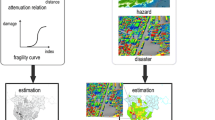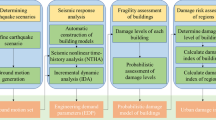Abstract
A multiple level-of-detail (LOD) simulation framework is proposed in this study, to take full consideration of the diversity of structural types, available data, and simulation scenarios in an actual application of seismic-damage simulation to urban buildings. Firstly, key features of the frequently used seismic simulation methods for buildings are discussed, and logical relationships of these simulation methods, as well as the available multi-source data, are established in different LODs. Secondly, implementation of the proposed multi-LOD simulation framework is presented, and a unified city data structure is proposed to enable effective management and storage of data with different LODs. Finally, the Beijing central business district, which has various types of buildings, is investigated in detail to demonstrate the proposed multi-LOD framework. The accuracy, efficiency, and corresponding requirements of different LOD simulations are compared and discussed. The outcomes of this work are expected to provide a useful reference for the application of seismic-damage simulations in complex urban areas.
















Similar content being viewed by others
References
Applied Technology Council [ATC] (1985) Earthquake damage evaluation data for California (ATC-13), Redwood, CA
Biljecki F, Ledoux H, Stoter J (2016) An improved LOD specification for 3D building models. Comput Environ Urban Syst 59:25–37
Borrmann A, Kolbe TH, Donaubauer A, Steuer H, Jubierre JR, Flurl M (2015) Multi-scale geometric-semantic modeling of shield tunnels for GIS and BIM applications. Comput Aided Civil Infrastruct Eng 30(4):263–281
MAE Center (2006) Earthquake risk assessment using MAEviz 2.0: a tutorial. Mid-America Earthquake Center, University of Illinois at Urbana-Champaign, Urbana-Champaign, IL
Ding B, Sun J, Du K, Luo H (2017) Study on relationships between seismic intensity and peak ground acceleration, peak ground velocity. Earthq Eng Eng Dyn 37(2):26–36 (in Chinese)
Eguchi RT, Goltz JD, Taylor CE, Chang SE, Flores PJ, Johnson LA, Blais NC (1998) Direct economic losses in the Northridge earthquake: a three-year post-event perspective. Earthq Spectr 14(2):245–264
Federal Emergency Management Agency [FEMA] (2012) Multi-hazard loss estimation methodology-earthquake model technical manual (HAZUS-MH 2.1), Federal Emergency Management Agency, Washington, DC
Fu CH (2012) A study on long-period acceleration response spectrum of ground motion affected by basin structure of Beijing. Doctoral dissertation, Institute of Geophysics, China Earthquake Administration, Beijing (in Chinese)
Gasparini D, Vanmarcke EH (1976) SIMQKE, A program for artificial motion generation. Department of Civil Engineering, Massachusetts Institute of Technology, Cambridge, MA
Graves RW, Pitarka A (2010) Broadband ground-motion simulation using a hybrid approach. Bull Seismol Soc Am 100(5A):2095–2123
Hori M, Ichimura T (2008) Current state of integrated earthquake simulation for earthquake hazard and disaster. J Seismol 12(2):307–321
Kircher CA, Reitherman RK, Whitman RV, Arnold C (1997) Estimation of earthquake losses to buildings. Earthq Spectr 13(4):703–720
Lu X, Lu XZ, Guan H, Ye L (2013) Collapse simulation of reinforced concrete high-rise building induced by extreme earthquakes. Earthq Eng Struct Dyn 42(5):705–723
Lu XZ, Han B, Hori M, Xiong C, Xu Z (2014) A coarse-grained parallel approach for seismic damage simulations of urban areas based on refined models and GPU/CPU cooperative computing. Adv Eng Softw 70:90–103
Lu XZ, Tian Y, Wang G, Huang DR (2018) A numerical coupling scheme for nonlinear time-history analysis of buildings on a regional scale considering site-city interaction effects. Earthq Eng Struct Dyn 47(13):2708–2725
McCormack TC, Rad FN (1997) An earthquake loss estimation methodology for buildings based on ATC-13 and ATC-21. Earthq Spectr 13(4):605–621
Mcguire RK (2010) Probabilistic seismic hazard analysis: early history. Earthq Eng Struct Dyn 37(3):329–338
Okada Y, Kasahara K, Hori S, Obara K, Sekiguchi S, Fujiwara H, Yamamoto A (2004) Recent progress of seismic observation networks in Japan—Hi-net, F-net. K-NET and KiK-net. Earth Planet Space 56(8):xv–xxviii
Pacific Earthquake Engineering Research Center [PEER] (2013) PEER Ground Motion Database. http://ngawest2.berkeley.edu/. Accessed 23 Sep 2018
Sa FMD, Oliveira CS, Ferreira MA (2013) SIRIUS, seismic risk indicator in urban space. Earthq Spectr 9(2):573–595
Shome N, Jayaram N, Krawinkler H, Rahnama M (2015) Loss estimation of tall buildings designed for the PEER tall building initiative project. Earthq Spectr 31(3):1309–1336
Singhal A, Kiremidjian AS (1996) Method for probabilistic evaluation of seismic structural damage. J Struct Eng 122(12):1459–1467
Wald DJ, Worden BC, Quitoriano V, Pankow KL (2005) ShakeMap manual: technical manual, user’s guide, and software guide. U.S. Geol Surv Tech Methods 12-A1
Xiong C, Lu XZ, Hori M, Guan H, Xu Z (2015) Building seismic response and visualization using 3D urban polygonal modeling. Autom Constr 55:25–34
Xiong C, Lu XZ, Hong G, Xu Z (2016) A nonlinear computational model for regional seismic simulation of tall buildings. Bull Earthq Eng 14(4):1047–1069
Xiong C, Lu XZ, Lin XC, Xu Z, Ye LP (2017) Parameter determination and damage assessment for THA-based regional seismic damage prediction of multi-story buildings. J Earthq Eng 21(3):461–485
Yin ZQ (1996) Classification of structure vulnerability and evaluation earthquake damage from future earthquake. Earthq Res China 12(1):49–55 (in Chinese)
Acknowledgements
The authors are grateful for the financial support received from the Natural Science Foundation of Guangdong Province (Grant No. 2017A030310076), the Natural Science Foundation of SZU (Grant No. 2017064) and the National Natural Science Foundation of China (Grant Nos. 51708361, U1709212).
Author information
Authors and Affiliations
Corresponding author
Additional information
Publisher's Note
Springer Nature remains neutral with regard to jurisdictional claims in published maps and institutional affiliations.
Rights and permissions
About this article
Cite this article
Xiong, C., Lu, X., Huang, J. et al. Multi-LOD seismic-damage simulation of urban buildings and case study in Beijing CBD. Bull Earthquake Eng 17, 2037–2057 (2019). https://doi.org/10.1007/s10518-018-00522-y
Received:
Accepted:
Published:
Issue Date:
DOI: https://doi.org/10.1007/s10518-018-00522-y




